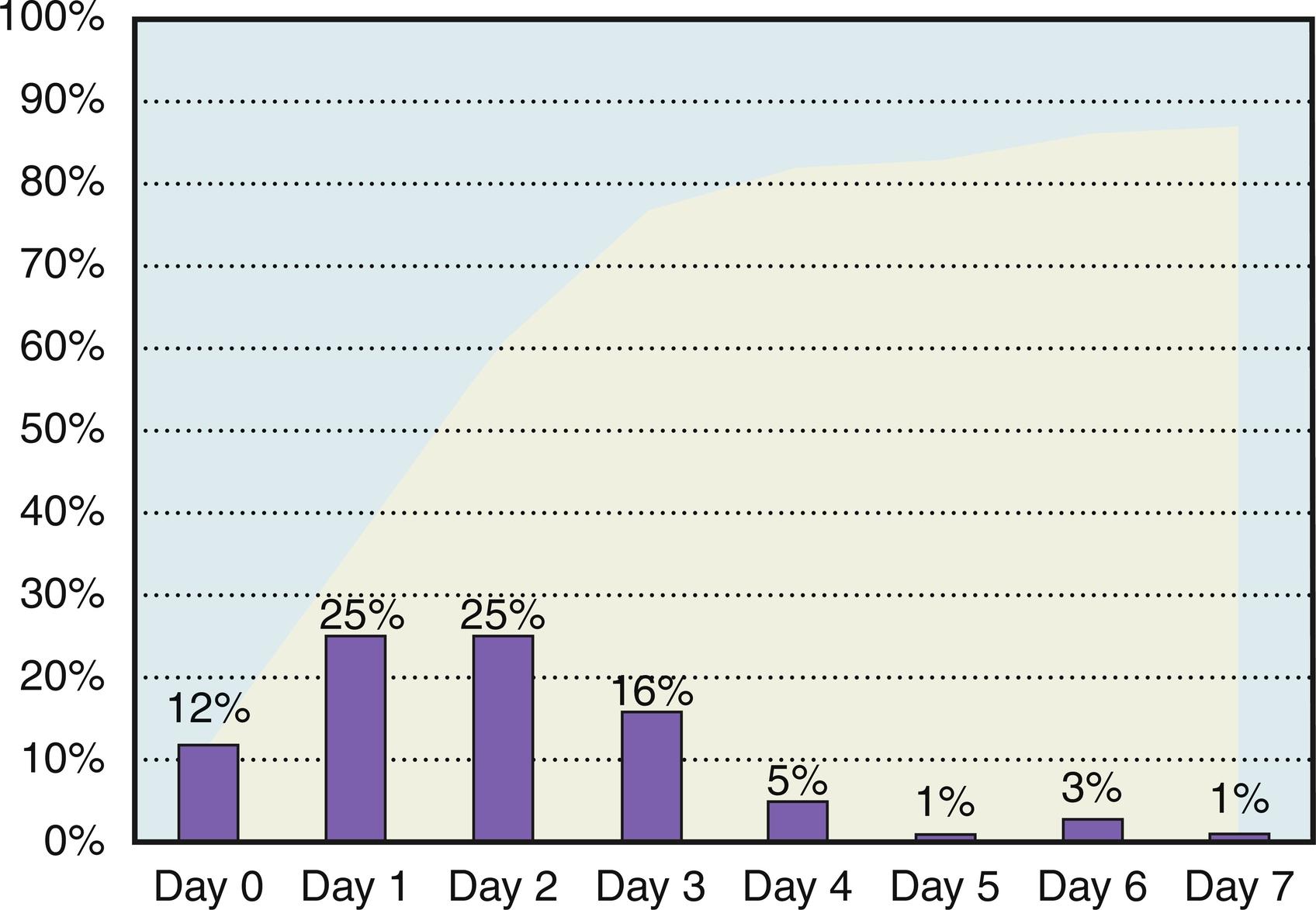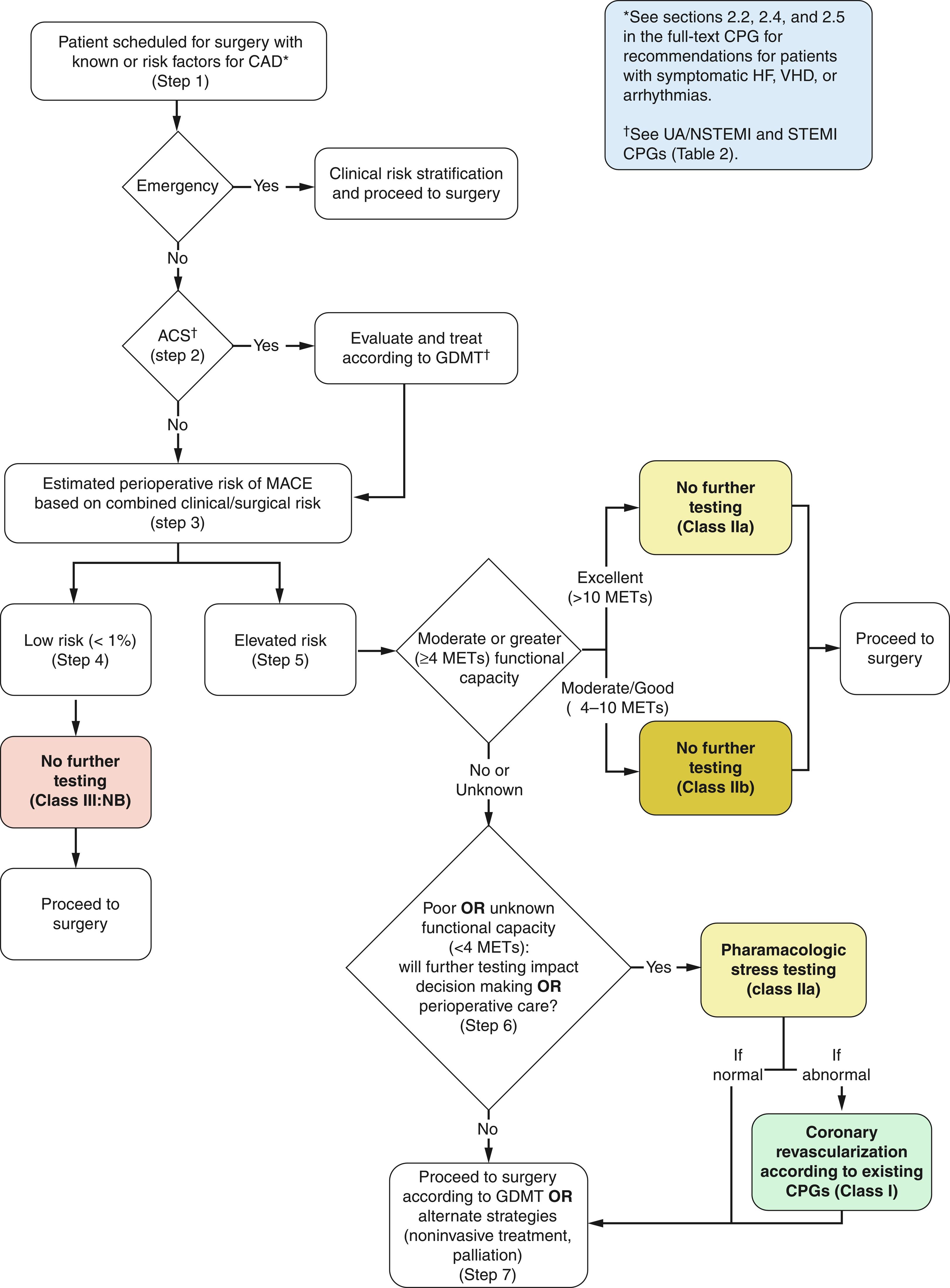Physical Address
304 North Cardinal St.
Dorchester Center, MA 02124
Perioperative myocardial infarction (MI) is the most common cause of death in the early postoperative period. Perioperative ischemia can be caused by either acute coronary thrombosis or by a mismatch between myocardial oxygen supply and demand. While the inflammatory response to surgery itself may be responsible for precipitating acute plaque rupture and MI, other hemodynamic disturbances, including hypertension/hypotension, tachycardia, acute blood loss, and anemia, may be also lead to ischemic events in vulnerable patients.
A comprehensive approach to the evaluation and management of patients at risk for major adverse cardiac events (MACE) in the perioperative period is essential to optimize outcomes in this population. In this chapter, we discuss the perioperative management of patients at risk of MI, including preoperative medical optimization, intraoperative management, and anesthetic selection. We also discuss emerging concepts in ischemia prevention. Emphasis is placed on current American College of Cardiology/American Heart Association (ACC/AHA) guidelines for perioperative management and the European Society of Cardiology/European Society of Anaesthesiology (ESC/ESA) guidelines on noncardiac surgery.
The pathophysiology of perioperative MI is complex and variable. Generally, there are two subtypes of perioperative ischemia: acute coronary syndrome from thrombotic occlusion of a coronary artery and demand ischemia. Demand ischemia is far more prevalent than acute coronary syndrome as the etiology of perioperative MI. Perioperative MI typically occurs in the first 4 postoperative days, although it can occur at any point during hospitalization ( Fig. 12.1 ).

In contrast to medical patients presenting with MI, who primarily die of thrombotic coronary occlusion, angiographic studies of patients who had a fatal perioperative MI showed a much lower rate of plaque rupture. This suggests that myocardial oxygen supply and demand mismatch play a much more prominent role in perioperative MI. Predictably, patients with a high burden of coronary artery disease preoperatively are at elevated risk for perioperative MI. The number and severity of lesions is correlated with the risk of perioperative mortality in vascular surgery patients, and the presence of a chronic total occlusion of a coronary artery with collateralization is common in patients experiencing perioperative MI.
The incidence of perioperative MI varies, depending on the definition used, but even a minor increase in serum troponin is associated with a significant increase in 30-day mortality, although a cause-and-effect relationship has not been firmly established. Importantly, studies suggest the majority of patients with perioperative MI will not present with symptoms of ischemia, and there should be a low threshold to initiate an ischemic workup in postoperative patients who demonstrate evidence of clinical decompensation. Ultimately, patients who develop perioperative MI are at a significantly increased risk of mortality, with the largest cohort to date examining outcomes in this patient population showing a fivefold increase in 30-day mortality in patients with perioperative MI.
A detailed discussion of preoperative cardiac assessment can be found in Chapter 5 . In general, risk stratification for noncardiac surgery is performed by assessing functional status and for the presence of comorbidities that predict an increased risk of MACE. Functional status can be determined formally, via exercise testing or a number of existing validated activity indices, or informally, by assessing activities of daily living. Patients who are unable to perform greater than 4 metabolic equivalents of activity are at increased risk of MACE, independent of other comorbidities. Similarly, elderly patients who have significant frailty, as defined by a number of scoring systems, are at increased risk of adverse perioperative events.
Assessment of preexisting comorbidities is also useful for defining perioperative risk, and there are a number of tools that can be used to help assess for risk of MACE. The revised cardiac risk index is a straightforward and easy method of estimating the risk of MACE. Patients are assessed for six criteria: (1) ischemic heart disease, (2) cerebrovascular disease, (3) serum creatinine > 2 mg/dL, (4) congestive heart failure, (5) insulin-dependent diabetes mellitus, and (6) high-risk surgery. Patients with zero or one criterion are at low risk for MACE, and patients who meet two or more criteria are at increased risk. While this algorithm played a central role in directing preoperative cardiac assessment in the 2007 AHA/ACC preoperative testing guidelines, its utility has been deemphasized in the 2014 edition of the guidelines in favor of more sophisticated indices of preoperative risk assessment, such as the American College of Surgeons National Surgical Quality Improvement Program, Myocardial Infarction or Cardiac Arrest, and surgical risk calculators. The current algorithm from the ACC/AHA guidelines for preoperative assessment detailing decision making for preoperative cardiac testing can be found in Fig. 12.2 .

The role of preoperative myocardial revascularization in the patient with significant coronary artery disease remains controversial, and current literature is conflicting as to its clinical benefit. Most large studies evaluating the utility of preoperative revascularization have been performed in the high-risk vascular surgery population. In 2004, the CARP (Coronary Artery Revascularization Prophylaxis) trial demonstrated no significant mortality benefit and no reduction in 30-day MI in patients who underwent preoperative revascularization with either percutaneous coronary intervention (PCI) or coronary artery bypass grafting (CABG).
The management of the patient undergoing preoperative evaluation who is found to have significant coronary artery disease depends on (1) the urgency of the surgery, (2) the anatomic distribution of their coronary artery disease, and (3) their degree of clinical symptoms. The most recent recommendations suggest that patients scheduled for an elevated-risk surgical procedure who are found to have coronary artery disease for which CABG is indicated should undergo CABG prior to proceeding with their originally scheduled procedure if the procedure is not of a time-sensitive nature. The role of PCI is less clear in the perioperative setting and should only be performed in those patients with left main coronary artery disease who are not candidates for CABG or patients with unstable angina or MI.
Importantly, patients presenting for elective surgery with a significant burden of coronary artery disease should be involved in the surgical decision-making process, with consideration for cancelation or delay of surgery if perioperative risk is felt to be high. Perioperative management and decisions regarding preoperative revascularization should be made with input from a multidisciplinary team, including the patient’s cardiologist, surgical team, and anesthesiologist.
Preoperative medication optimization has remained a major focus in the anesthetic literature, with numerous major clinical trials attempting to ascertain the potential of various medications to prevent perioperative ischemic events. Although a number of medications have been evaluated, determining the optimal medical regimen for preventing perioperative ischemic events remains under investigation. Here, we review the current evidence for common medications, as well as the current guidelines for perioperative medication management.
The use of beta-adrenergic blocking agents in the perioperative period has been a subject of intense clinical investigation. In general, research into the management of beta-blockers in the perioperative period has focused on the management of patients already taking beta-blockers with examination of the effect of beta-blocker discontinuation and on patients who are not taking beta-blockers preoperatively but are deemed to be at elevated risk of perioperative MACE.
The continuation of beta-blockade in patients previously taking beta-blockers is a core measure in the Surgical Care Improvement Project, with a Class I recommendation in the current ACC/AHA guidelines. Interestingly, despite an extensive body of prospective literature examining initiation of beta-blockade in the perioperative period, the evidence for beta-blocker continuation is still evolving. A 2001 study of 140 vascular surgical patients showed a 50% mortality rate in patients who had beta-blockers discontinued in the early postoperative period, but this group only constituted 8 patients out of a cohort of 140. Hoeks and colleagues examined a similar cohort of 711 vascular surgery patients and found an increase in 1-year mortality in patients who had their beta-blockers discontinued perioperatively. These two studies formed the basis for the initial recommendation for beta-blocker continuation in the 2007 ACC/AHA guidelines. More recent studies examining larger cohorts showed a less dramatic difference but collectively concluded that continuation of beta-blockers was associated with a lower overall risk of cardiovascular events and mortality in patients receiving them preoperatively.
With regard to the initiation of beta-blockade in the perioperative period, the available evidence suggests that initiation on the day of surgery may potentially be detrimental. The largest study to date evaluating perioperative beta-blocker administration was the POISE (PeriOperative ISchemic Evaluation) trial. This trial prospectively randomized over 8000 patients to high-dose, extended-release metoprolol or placebo beginning on the morning of surgery and continuing for 30 days. While the administration of metoprolol was found to be associated with a lower risk of MI, there was an overall increase in the risk of stroke and mortality. In 2014, the ACC/AHA Task Force on Practice Guidelines issued a systematic review specific to perioperative beta-blocker therapy. Consistent with the POISE trial, this systematic review examining over 12,000 patients demonstrated that the initiation of beta-blocker therapy within 1 day of surgery was associated with an overall decrease in the incidence of MI but an increase in stroke, hypotension, and bradycardia. This study also suggested a possible increase in cardiac and all-cause mortality in this population. To date, the effect of initiating beta-blocking medications days to weeks in advance of an operation has not been rigorously evaluated and remains a focus of continued investigation.
Become a Clinical Tree membership for Full access and enjoy Unlimited articles
If you are a member. Log in here